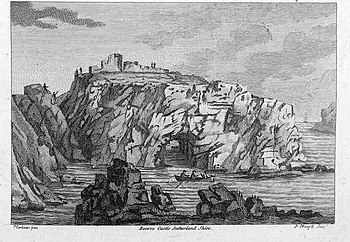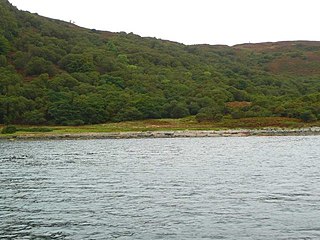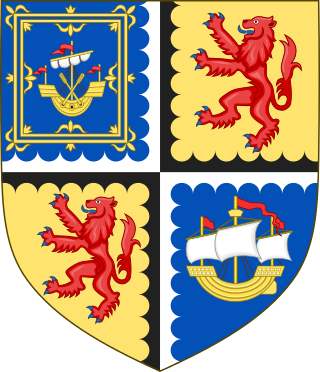
Borve Castle in Sutherland, Scottish Highlands is now a ruin. Formerly called the House of Burro. It was built in Kirtomy Bay near the hamlet of Farr. [1] It is also known as Farr Castle. [2]

Borve Castle in Sutherland, Scottish Highlands is now a ruin. Formerly called the House of Burro. It was built in Kirtomy Bay near the hamlet of Farr. [1] It is also known as Farr Castle. [2]
The castle, which may have originally been constructed by a Norseman by the name of Torquil, [3] was a stronghold of Clan Mackay that they used as a base to carry out raids on their neighbours the Clan Sutherland. [1] The Mackays failed to appear in front of Mary of Guise, the mother of Mary, Queen of Scots, and as a result John Gordon, 11th Earl of Sutherland, chief of Clan Sutherland was ordered to destroy the castle. [1] Guise hired a private ship, the Lion in August 1554 to attack the Castle. Hugh Kennedy of Girvanmains, the Earl's stepfather (or Stepbrother), embarked 50 men of war and the royal gunner Hans Cochrane with a cannon. [4] It is also said that a cannon was dragged all the way from Edinburgh. [1] Rory Mor Mackay, Captain of the castle was apparently dismayed to see that the enemy was armed with a cannon as the castle had withstood all previous sieges. [5]
The castle was partly destroyed and garrisoned for the Queen Regent by John Williamson. He was supplied with food from the lands of Helena Sinclair, the widow of Donald Mackay of Strathnaver. [6] Rory Mor Mackay was hanged. [1] In November Kennedy returned to Edinburgh with Iye Du Mackay, 12th of Strathnaver who was imprisoned in Dumbarton and then Edinburgh Castle. [7]
After Borve Castle was taken, a force from the Clan Mackay assembled under John Mor Mackay and engaged in battle with the Clan Sutherland, known as the Battle of Garbharry where the Mackays were defeated. This was the last battle between the clans Sutherland and Mackay. [8]
Historian Sir Robert Gordon (1580–1656) (a younger son of Alexander Gordon, 12th Earl of Sutherland) wrote of the siege of Borve Castle in his book "A Genealogical History of the Earldom of Sutherland":
The Queen granted commission to John Gordon, Earl of Sutherland, against Iye MacKay and his country. The Earl of Sutherland, assisted by Huntly, and having the regent's commission, raised an overwhelming force, and for the first time that ever any Earl of Sutherland adventured to do so, invaded MacKay's country. So Earl John assembling all his forces, entered into Strathnaver, sack-ing and spoiling before him in a hostile manner, and possessed all the places of doubt, lest, as Hollinshed sayeth, any hole might be left for them to pass away from thence. But when Earl John perceived that Iye MacKay would not abide and fight him, he besieged the strong castle and fort called Borwe, the principal strength of that country, not two miles distant from Far. After a short siege, he took it by force, and hanged Rory MacKean-Voir, captain thereof. [9]
Written from a manuscript wrote in the reign of James VI of Scotland (Sir Robert Gordon's A Genealogical History of the Earldom of Sutherland).

Clan Mackay is an ancient and once-powerful Highland Scottish clan from the far North of the Scottish Highlands, but with roots in the old Kingdom of Moray.

Clan Gunn is a Highland Scottish clan associated with lands in northeastern Scotland, including Caithness, Sutherland and, arguably, the Orkney Isles. Clan Gunn is one of the oldest Scottish Clans, being descended from the Norse Jarls of Orkney and the Pictish Mormaers of Caithness.

Clan Sutherland also known as House of Sutherland is a Highland Scottish clan whose traditional territory is the shire of Sutherland in the far north of Scotland. The chief of the clan was also the powerful Earl of Sutherland, however in the early 16th century this title passed through marriage to a younger son of the chief of Clan Gordon. The current chief is Alistair Sutherland who holds the title Earl of Sutherland.

The Battle of Tannach was a Scottish clan battle fought about 3 miles (4.8 km) southwest of Wick, in the far north of Scotland. It was fought between men of the Clan Keith and Clan Mackay from Strathnaver against men of the Clan Gunn and possibly their allies the Clan Oliphant and Clan Sutherland from Caithness. The date is uncertain, it was probably in 1464 but may have been in 1438.

The Battle of Garbharry was a Scottish clan battle fought in the year 1555. It was the last battle to be fought between the Clan Mackay and Clan Sutherland. It was fought "beside the water of Garbharry", at "the foot of the hill called Beinn-mhor, in Berriedale". This has been recognised as the area around Garvery Hill, including Big and Little Garvery Burn, just south of Morven, where presumably some of the soldiers drowned.

The Battle of Allt Camhna was a Scottish clan battle fought in 1586 between the Clan Gunn and Clan Mackay against the Clan Sinclair.

The Battle of Leckmelm was a Scottish clan battle that took place in 1586, in the Scottish Highlands. It was fought between the Clan Gunn against the Clan Sutherland, Mackays of Aberach and the MacLeods of Assynt.

Dingwall Castle was a medieval fort and royal castle in the town of Dingwall, eastern Ross-shire, Scotland.
Huistean Du Mackay, 13th of Strathnaver, was the thirteenth chief of Clan Mackay, a Highland Scottish clan.

The Battle of Alltachuilain (or Ald-Quhillin was a Scottish clan battle that took place in 1518 or 1519 in the parish of Loth, county of Sutherland, Scotland. It was fought between factions of the Clan Sutherland in a dispute over the Earldom of Sutherland.

The Battle of Clynetradwell was a Scottish clan battle that took place in 1590 in the county of Sutherland between the forces of Alexander Gordon, 12th Earl of Sutherland and George Sinclair, 5th Earl of Caithness.
Iye Du Mackay, 12th of Strathnaver, was the chief of the Clan Mackay, a Highland Scottish clan, from 1550 to 1572.

The Mackays of Scoury were a minor noble Scottish family and a branch of the ancient Clan Mackay, a Highland Scottish clan. They were seated at Scourie Castle, in Scourie, in the parish of Eddrachillis, county of Sutherland. However, Scourie was part of the Mackay chief's province of “Strathnaver” until it was sold to the Earl of Sutherland in 1829.
Iye Mackay, 4th of Strathnaver was the chief of the ancient Clan Mackay, a Scottish clan of the Scottish Highlands. He was murdered along with his eldest son Donald at Dingwall Castle during a feud with the Earl of Sutherland, chief of the Clan Sutherland.
Donald Mackay, 5th of Strathnaver, was the fifth chief of the ancient Clan Mackay, a Scottish clan of the Scottish Highlands.
Angus Roy Mackay, 9th of Strathnaver, was the ninth chief of the ancient Clan Mackay, a Scottish clan of the Scottish Highlands.
Iye Roy Mackay, 10th of Strathnaver, was the tenth chief of the ancient Clan Mackay, a Scottish clan of the Scottish Highlands.
John Mackay, 11th of Strathnaver, was the eleventh chief of the ancient Clan Mackay, a Scottish clan of the Scottish Highlands.
Donald Mackay, 11th of Strathnaver, was the eleventh chief of the ancient Clan Mackay, a Scottish clan of the Scottish Highlands.

George Sinclair was a Scottish nobleman, the 5th Earl of Caithness and chief of the Clan Sinclair, a Scottish clan based in northern Scotland.